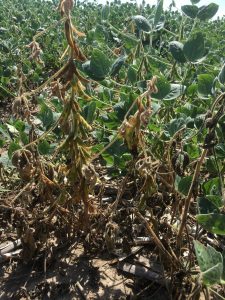How to Identify Late Season Soybean Diseases
By Dr. Anne Dorrance, The Ohio State University Extension, Plant Pathology Specialist, Adapted from C.O.R.N. 2020-27
Sclerotinia stem rot – The nights have been cool this growing season, even when the days were very warm. This is the time of the year to begin to scout for this stem disease. Sclerotinia is caused by a fungus that survives from season to season and over several years from sclerotia.

The infections actually occurred during flowering when the canopy was closed, and cool nights can really enhance and favor this disease. For this disease, disease levels can reach 20% incidence before there is a measurable yield loss. Sclerotinia will occur as single plants or small patch of dying plants, that wilt and turn a deeper olive green color. Look at the stem and white fluffy growth will appear on the stem, this is the sign of the fungus.
Sudden Death Syndrome – reports that this disease is also beginning to develop in some areas of the state where soybeans are reaching R6. Symptoms include irregular yellow spots, which turn brown or necrotic between the veins. Interestingly the veins are surrounded by green. The center of the stem or pith is bright white in this disease. This is a fungal pathogen and infections most likely occurred shortly after planting and this fungus causes extensive root rots. There is a look alike symptom caused by triazole fungicides when applied under hot conditions. To separate these two, if a triazole had been sprayed, look at the roots. The roots will be very healthy where SDS, the roots and the center of the tap root are discolored.

Diaporthe stem canker (northern and southern) have both been problems in recent years. On susceptible cultivars the plants will die early in patches. For Northern, there is a canker at the third node which girdles the plant. For Southern, there can be several reddish cankers on the stem and the internal pith tissue is a reddish brown.
Phytophthora stem canker – numerous reports this year due to localized flooding events and in places that have not reported it very frequently. Phytophthora stem canker will occur 1 to 2 weeks after a heavy rain and in fields
with poor drainage. The plants will wilt first, leaves will turn yellow, and a choc olate brown canker will form from the bottom of the plant to almost mid-height. The key difference between this and Northern Diaporthe stem canker is the length of the canker and where it originates. If the canker begins below ground, the roots are discolored it is Phytophthora.
olate brown canker will form from the bottom of the plant to almost mid-height. The key difference between this and Northern Diaporthe stem canker is the length of the canker and where it originates. If the canker begins below ground, the roots are discolored it is Phytophthora.
For additional pictures and information, visit: https://agcrops.osu.edu/newsletter/corn-newsletter/2020-27/how-identify-late-season-soybean-diseases-2020